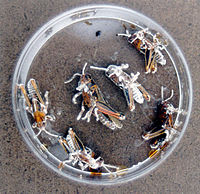Beauveria bassiana
| Beauveria bassiana | |
|---|---|
 |
|
| Grasshoppers killed by B. bassiana | |
| Scientific classification | |
| Kingdom: | Fungi |
| Division: | Ascomycota |
| Class: | Sordariomycetes |
| Order: | Hypocreales |
| Family: | Clavicipitaceae |
| Genus: | Beauveria |
| Species: | B. bassiana |
| Binomial name | |
|
Beauveria bassiana (Bals.-Criv.) Vuill. (1912) |
|
| Synonyms | |
|
|
Beauveria bassiana is a fungus that grows naturally in soils throughout the world and acts as a parasite on various arthropod species, causing white muscardine disease; it thus belongs to the entomopathogenic fungi. It is being used as a biological insecticide to control a number of pests such as termites, thrips, whiteflies, aphids and different beetles. Its use in the control of bedbugs and malaria-transmitting mosquitos is under investigation.
The species is named after the Italian entomologist Agostino Bassi, who discovered it in 1815 as the cause of the muscardine disease which then led to carriers transmitting it by airborne means. It was formerly also known as Tritirachium shiotae. The name B. bassiana has long been used to describe a species complex of morphologically similar and closely related isolates. Rehner and Buckley have shown that B. bassiana consists of many distinct lineages that should be recognized as distinct phylogenetic species and the genus Beauveria was redescribed with a proposed type for B. bassiana in 2011. In light of this work and the known existence of cryptic species, it is important to characterise isolates used to develop biological insecticides.
Beauveria bassiana is the anamorph (asexually reproducing form) of Cordyceps bassiana. The latter teleomorph (the sexually reproducing form) has been collected only in eastern Asia.
...
Wikipedia
